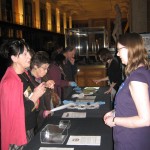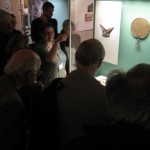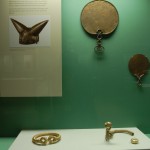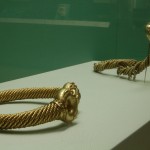Total posts:
187
12/14/2010
Today I am off to Jelling which, after Legoland (presumably), is the place of greatest cultural importance to Danes. This was the royal seat of Gorm ‘the old‘ who created the Danish state in the C10th. His son Harald I ‘Bluetooth’, who became king in 950, adopted Christianity soon after, and moved his father’s body from one of the giant burial mounds to a church he had built between them. Harald also erected a rune stone (pictured), dedicated to his father (King Gorm) and mother (Thyra), which also says Harald ‘won for himself Denmark the whole and Norway and made the Danes Christian‘. A second rune stone was erected by King Gorm for his wife. [my Danish colleagues have been correcting me on the history, hence the changes in bold].
The train to Jelling was delayed by 20min! - for a moment I felt like I was at home, but to fair rail in the UK is quite reliable these days, unless it is raining, there are leaves on the line, its snowing, or it gets too hot…
Jelling, though a small place, was very impressive. The museum (which is free) is also well worth a visit, and I was treated extremely hospitably – they even made me tea, with milk! Besides the Jelling cup, which is smaller than I imagined and gives its name to the art style upon it, I was amazed by the finds of wooden spades and even a wheel-less barrow, used by the workmen who built the great mounds. There is also quite a bit about Queen Thyra, who is thought of quite highly by Danes, past and present.

Danish facts: The current queen of Denmark, Queen Margrethe II, is very interested in archaeology, and as a young girl she dug on quite a few excavations (there is an exhibition about it at the Nationalmuseet).
On the train I have been reading about C11th Danish coinage. Interestingly English dies (and later English moneyers) were sent to Denmark, and hence much of this early coinage follows English designs. Even more remarkably this happened before the Danish Conquest of England in 1013/14. I have also been given a book about Roman coin finds in Denmark – which I’ll let the coin freaks in PAS read! Trying not to sound ungrateful, I was hoping to avoid the Romans when I came here. I mean, what did the Romans ever do for us?… (please don’t post replies on that).
Tonight I am attending a couple of lectures (in Danish!) hosted by Det Kongelige Nordiske Oldskriftselskab, so I’d better dash (and remember my phrase book)…
Well, I am afraid my Danish is a bit rusty. The talks were on excavations at Lejre and recent geo-phizz work. The highlight for me was the parallels between figurines believed to be Odin found at Lejre and Harold II in the Bayeux Tapestry – though doubt the Tapestry designer (an Englishman of course) ever made a trip this far north.
12/14/2010
Yesterday (13 December) staff from the department of Portable Antiquities & Treasure (PA&T) and Conservation and Scientific Research (CSR) took part in a host of activities as part of a ‘Treasure’ themed evening for the Friends of the British Museum. These evenings, where members have an exclusive opportunity to learn from the experts about current operations at the museum, are one of the advantages of being a ‘BM Friend’.

The Treasure Team was stationed in the Enlightenment Gallery with a selection of items that have been reported as potential Treasure and which have come to the museum for analysis and/or valuation. Hilary Orange took charge of the table and chose an array of objects designed to engage visitors with the concept of ‘Treasure’ and the intricacies of its definition. Among the items was a silver finger-ring NARC-EC8B41 from Northamptonshire, two of the largest Iron Age ingots from this case IOW-EAAFE2 on the Isle of Wight, and three Bronze Age palstaves from this hoard HAMP-4DE734 in Hampshire. Hilary and Caroline Lyons had also created a collage of press reports about finds of Treasure, and images of treasure items that had been valued, and used these to decorate the stand. The overall effect was to ensure that a constant stream of curious Friends visited with the team for over two and a half hours.

Caroline Lyons, Caroline Barton, Janina Parol and myself (Ian Richardson) also conducted gallery talks throughout the evening, taking visitors through the British Museum’s European Galleries in order to highlight a few of the more prominent cases of Treasure that the British Museum has acquired, both under the old law of Treasure Trove and under the ‘new’ Treasure Act. We also included as a point-of-interest the case in the Early Medieval gallery currently occupied by the Frome Hoard and the Hackney Hoard, and were able to use that to explain more fully about the logistics behind the Treasure Act, and that most things which come to the BM under the Act are in fact acquired by local museums. Sue Brunning, project curator in the Department of Prehistory and Europe, was at the same time drawing large crowds to her gallery talks about Sutton Hoo.

Meanwhile, in the depths of the Clore Centre, below the Great Court, Dan Pett used an internet connection to give live demonstrations of the PAS Database. This generated intense interest from some of the guests and Dan found himself the object of much attention through the evening. In the same part of the museum, Roger Bland and Sam Moorhead packed the largest lecture theatre with an enthralled audience as they detailed the history of the discovery, excavation, cataloguing and acquisition of the Frome Hoard.
In the Great Court itself, curious Friends were given insight into the scientific aspect of Treasure by Duncan Hook and Sue LaNiece of CSR. With their portable XRF machine, they demonstrated how metallic items can be tested for gold or silver content without having to incurring any physical damage at all. The original plan was for the Treasure Team to bring over one of the items it had on display, a replica Viking comb from Devon that was originally believed to be silver until analysis showed it to be made of modern pewter, in order that Sue and Duncan could show the visitors an ‘authentic’ case. However the volume of patrons who patrolled the Treasure desk made escape impossible!
Paula Carter, the co-ordinator of Members Open Evenings said:
It was a very busy evening and the Members were clearly very much engaged in the whole of the evening’s programme, there was a wonderful atmosphere and I heard lots of excited discussions amongst members and they compared notes on what they had seen so far
What I saw certainly reinforced that. Walking through the Great Court at the end of the evening two gentlemen in important looking suits were conversing together as they strode towards the exit.
‘I had no idea Britain had its own emperor,’ said one.
‘No, no, neither did I,’ returned his companion. ‘Fascinating’.
Whether they owe their newfound knowledge to Roger and Sam, or to the fevered cramming of an Assistant Treasure Registrar, proudly regaling the history of Carausius and the gold coin DENO-651C91 in our galleries, remains unknown.
12/13/2010
Arrived in Denmark late last night, after a pleasant flight with Atlantic Airlines. Spent most of the flight reading Beowulf – the first travel guide written in English about Denmark – and now I am a bit worried about going to any public houses (aka mead-halls) here! The transfer from Copenhagen central station to the airport was very quick (12mins), which contrasted to the trip to the airport in London…
Danish fact: Danish is a very complicated language, and even the Danes aren’t that good at writing it: they always seem to be crossing letters out. Maybe that is why everyone speaks English so well…
12/13/2010
My first day at the Nationalmuseet where I am being looked after by Lisbeth Imer, an expert on runic inscriptions. It has been fascinating learning about danefæ (treasure trove), which I have had the opportunity to discuss with curators in both the medieval (c.1000 onwards) and coins departments. Here any object which is danefæ (i.e. dating to before 1536 and selective items thereafter) is acquired, and the finder is payed a reward (not necessarily equal to its market value). Coin finds are acquired by the national museum, whilst many other finds end up in various local museums. Amazingly, museums do not have to bid for funding to acquire finds (as is the case in the UK) - the state simply supplies the cash! It obviously saves the curators lots of work…
Since the danefæ dates back 1241 it seems pretty fairly ingrained in the Danish consciousness that history is important, finds should be reported and the best place for them is in public collections.
Danish fact: not everything costs lots of money in Denmark – lunch in the Nationalmuseet canteen cost only 17Kr (about 2 quid).
This afternoon Anne Pedersen and myself discussed the potential for detector finds to advance archaeological knowledge of the C10th to C12th. It is readily apparent much more could be done to understand the stylistic influences on metalwork on both sides of the North Sea at this time.
This evening I crossed the ‘sea-lanes’ to Geatland. There, at Malmo Cathedral they were celebrating the festival of St Lucy (picture), which seems to be a cross between a carol service and Christingle. Unlike Beowulf, I crossed back into Denmark unchallenged by the Shieldings’ lookout…
12/10/2010
Newark and Sherwood District Council have agreed to loan the Newark Torc to the British Museum, where it is now on display.

The Department of Prehistory & Europe has arranged a case in the Britain and Europe (800BC – AD43) gallery to display the Newark Torc alongside the British Museum’s own ‘Sedgeford Torc’, found in 1965. Both torcs date to the pre-Roman Iron Age and are composed of twisted gold wire strands attached to hollow terminals, embellished with ‘La Tene’ decoration. This design allowed for a natural flex in the band to accommodate the twisting action necessary to slip the decoration around the wearer’s neck.
The pairing of the torcs from Newark and Sedgeford enables visitors to appreciate both the magnificence of a complete example and the complex craftsmanship behind its construction, for historic damage to the Sedgeford Torc has created the effect of an exploded schematic and shows clearly the object’s separate components. The larger section of the torc has been slightly unwound and makes it easier to see the technique involved in braiding the gold wires; similarly, the dislocated terminal (found separately, in 2004 by the Sedgeford Historical Archaeology Research Project) allows visitors to see the way that the wires were joined together.

The Newark Torc was found in April 2005 and declared Treasure in May of that year. Subsequently acquired by Newark and Sherwood District Council, it is awaiting the creation of a suitable display space in the region. In the meantime, the exhibit at the British Museum assumes a place across the corridor from a larger showcase displaying the Great Torc from Snettisham and an assortment of torcs of different styles. As such, the Newark Torc nicely complements the BM’s Iron Age collection, and it is sure to have an even more significant impact when it goes home to Nottinghamshire.
12/10/2010
The British Museum (London) has an ‘exchange programme’ with the Nationalmusset Danmark (Copenhagen), whereby researchers at either institution travel across the North Sea (in a more friendly manner than in the past) to spend time with colleagues at the other museum ‘in order to learn how their areas of museum business are conducted in another international museum, learning and sharing knowledge’. Next week (13-17 December) Michael Lewis (Deputy Head, PAS) will be going to Copenhagen to meet with museum staff, undertake research on archaeological finds found by the Danish public, and meet with Danish metal-detector users. Follow his blog to find out how the trip goes…





